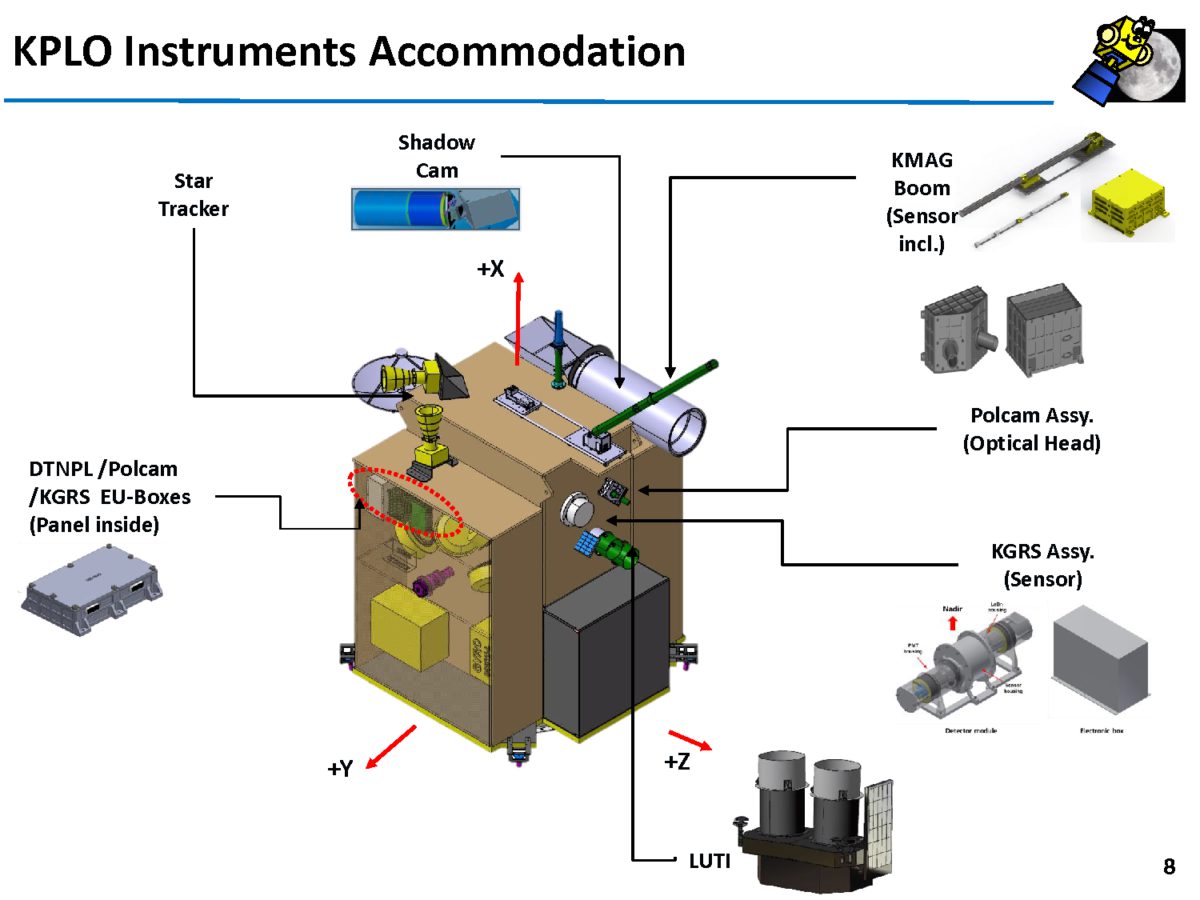Emily Lakdawalla • Dec 07, 2017
South Korea's first lunar mission planned for 2020
Last week I wrote about India's first lunar lander, launching in March. This week, I have another story about a future Asian lunar mission: the Korea Pathfinder Lunar Orbiter (KPLO), being developed by the Korea Aerospace Research Institute (KARI) of South Korea. It has long been slated for launch in December 2018, but now has a revised launch date of December 2020.* It will be Korea's first spacecraft beyond Earth orbit. Like India and China, Korea plans an ambitious line of lunar missions to steadily ramp up capability in deep space.

This blog post is based largely upon the slides from a presentation (PDF) made by KARI principal researcher Gwanghyeok Ju to NASA's Lunar Exploration Analysis Group meeting in October, which I hope I have interpreted correctly. Additional information is from NASA and ASU. Any errors are, of course mine.
KPLO is a small (550-kilogram) spacecraft. It will be mostly Korean-built with some technical support from NASA, particularly in the areas of telecommunications, navigation, and mission design. After launch on a commercial launch vehicle, it will take a month to reach the Moon (using a "phasing loop transfer" trajectory involving three and a half orbits of Earth, pumping the altitude up toward lunar orbit insertion) and will have a nominal mission lasting one year. Propulsion will be from four 30-newton thrusters and four 5-newton attitude control thrusters. Once at the Moon, its orbit will be polar and nearly circular with an altitude of about 100 kilometers.

For KPLO, Korea is developing a package of 4 science instruments totaling about 25 kilograms:
- LUnar Terrain Imager (LUTI) will perform high-resolution imaging of the lunar surface to map future landing sites and other "interesting places." The principal investigator is Haeng-Pal Heo of KARI.
- Polarimetric Camera (PolCam) will perform polarimetry in three UV/visible wavelengths (320, 430, and 650 nanometers), studying the lunar surface at phase angles from 0 to 120 degrees. The principal investigator is Young-Jun Choi of the Korea Astronomy and Space Science Institute (KASI).
- KPLO Magnetometer (KMAG) is a flux gate magnetometer that will map the lunar magnetic field and focus particularly on lunar swirls. The principal investigator is Ho Jin of Kyung Hee University (KHU).
- KPLO Gamma Ray Spectrometer (KGRS) will map the surface distribution of major elements (including Mg, Ni, Cr, Ca, Al, Ti, Fe, Si, O, U, and He-3) and water. The principal investigator is Kyeong-Ja Kim of the Korea Institute of Geoscience and Mineral Resources (KIGAM).
In addition, NASA's Advanced Exploration Systems Division (which is part of the human spaceflight side of NASA, not the science side) is providing one instrument:
- ShadowCam is a 10-kilogram camera with Lunar Reconnaissance Orbiter Camera heritage but 800 times greater sensitivity, which has the goal of imaging inside permanently shadowed craters near the poles. The principal investigator is Mark Robinson of ASU.
The mission is also focused on developing some enabling technologies, like disruption-tolerant networking. KPLO will be launched on a commercial space launch vehicle, but no contract has been signed yet. (When I began the research for this article, I thought it was launching in a year; now that the launch has been delayed to 2020, it makes a lot more sense that the rocket hasn't been bought yet.)
One of the challenging hurdles in front of an organization graduating from operating in near-Earth to deep space is telecommunication. KARI will update an existing satellite communication center to be compatible with NASA's Deep Space Network (DSN). KARI is also working with NASA to prepare to archive their data to standards compatible with NASA's Planetary Data System and ESA's Planetary Science Archive. There wouldn't be any reason to do that unless they planned on sharing their data with the world, so that's welcome news.
Following a hopefully-successful KPLO, South Korea has plans for several future missions. A second Chandrayaan-2-like mission could have an orbiter, lander, and rover, but it seems the details are still up in the air. The second mission would nominally be launched on Korea's own rocket, the KSLV-II. A major goal of a second mission would be to demonstrate a domestically-produced upper stage for the KSLV-II, so the launch date for a second lunar mission is tied to that development effort.
Here is Gwanhyeok Ju presenting the Korean lunar program and KPLO to the NASA Exploration Science Forum in July. It opens with the acknowledgment of the recent impeachment of South Korean president Park Geun-Hye. Since KPLO was initiated under her watch, it apparently was not obvious that it would continue after the impeachment, but Ju confirmed that the mission was going forward, albeit with a delayed launch date. (I don't think the launch delay is connected with the political turmoil in any way.)
*The December 2020 launch date was confirmed to me by NASA's John Guidi, but Ju mentions in the above July presentation that they were negotiating the delay at that time.
Let’s Go Beyond The Horizon
Every success in space exploration is the result of the community of space enthusiasts, like you, who believe it is important. You can help usher in the next great era of space exploration with your gift today.
Donate Today

 Explore Worlds
Explore Worlds Find Life
Find Life Defend Earth
Defend Earth

